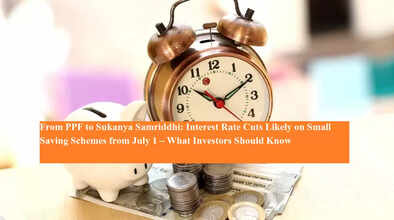From PPF to Sukanya Samriddhi: Interest Rate Cuts Likely on Small Saving Schemes from July 1 – What Investors Should Know

If you're investing in small saving schemes like PPF, Sukanya Samriddhi Yojana, or Senior Citizens Saving Scheme, a significant update may be on the horizon. Starting July 1, 2025, the Government of India may revise and potentially reduce interest rates on these popular schemes, impacting returns for crores of small investors.
Let’s take a closer look at why this change is expected, how it connects to broader economic indicators, and what it means for your financial planning.
🔍 Why Are Small Saving Scheme Rates Under Review?
Interest rates on small savings instruments such as Public Provident Fund (PPF), National Savings Certificate (NSC), and Post Office Time Deposits are reviewed quarterly by the Ministry of Finance. The next scheduled review is on June 30, 2025, and any changes will apply from July to September 2025.
So far in 2025, interest rates on these schemes have remained unchanged. However, macroeconomic signals suggest a rate cut is likely.
📉 RBI's Repo Rate Cuts Are Driving This Shift
The Reserve Bank of India (RBI) has cut the repo rate thrice in 2025:
-
February: 25 basis points (bps)
-
April: Another 25 bps
-
June: A substantial 50 bps cut
In total, the RBI has lowered the repo rate by 100 basis points (1%) this year.
As a result:
-
Commercial banks have started lowering fixed deposit (FD) rates
-
Some banks have withdrawn special FDs, which offered higher interest for limited periods
This cascading effect often influences government-backed small saving schemes, though the final call remains with the Finance Ministry.
📉 Bond Yields Also Indicate Lower Returns
Another critical factor is the fall in government bond yields, which are directly tied to how small saving rates are determined.
According to data from Investing.com:
-
The 10-year G-sec bond yield was 6.779% on January 1, 2025
-
By June 24, it had fallen to 6.247%
This 0.532% drop reflects reduced market expectations on returns, strengthening the case for a cut in interest rates on small savings instruments.
🧮 The Gopinath Committee Formula: How Rates Are Set
Interest rates for schemes like PPF are linked to the recommendations of the Shyamala Gopinath Committee, which the government has adopted. Here’s how it works:
-
Rates are benchmarked to secondary market yields of government securities (G-secs) of similar maturity
-
A positive spread of 25 basis points is added to protect savers
For example:
-
The average 10-year G-sec yield between March 24 and June 24, 2025, is 6.325%
-
Adding the 25-bps spread gives 6.575%, which is lower than the current PPF rate of 7.10%
This implies that, based on the formula, the PPF rate could be revised downwards.
🧾 What Could Change from July 1?
| Scheme | Current Interest Rate | Expected Rate (Estimated) |
|---|---|---|
| PPF | 7.10% | 6.6–6.7% |
| NSC | 7.7% | May see slight cut |
| Sukanya Samriddhi Yojana | 8.2% | May fall to 7.9–8.0% |
| Senior Citizens Saving Scheme | 8.2% | Likely minor revision |
| Post Office TD (5-Year) | 7.5% | Likely downward |
Note: These are estimates based on prevailing market data. Actual rates will be announced by the Finance Ministry.
🧠 What Should Investors Do?
If you're planning to invest in any small saving scheme, now may be a good time to act before rates potentially drop. Here are a few tips:
-
Lock in current rates by investing before July 1
-
Diversify your investments between FDs, mutual funds, and small savings
-
Senior citizens can still enjoy relatively higher returns under SCSS, even if rates dip slightly
-
Don’t panic—even after a rate cut, small saving schemes will likely still offer better returns than regular bank FDs
🔚 Final Thoughts
While the government hasn't yet officially confirmed any rate cuts, all economic indicators—from falling repo rates to declining bond yields—suggest a downward revision in interest rates on small saving schemes is highly likely.
Investors should stay alert, monitor announcements from the Finance Ministry, and consider locking in current returns before July 1, 2025.

